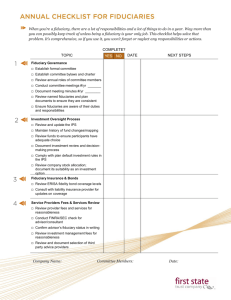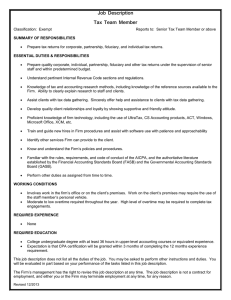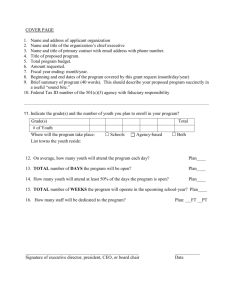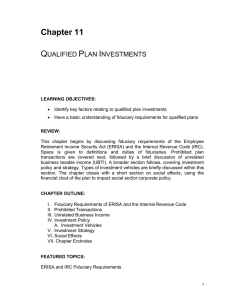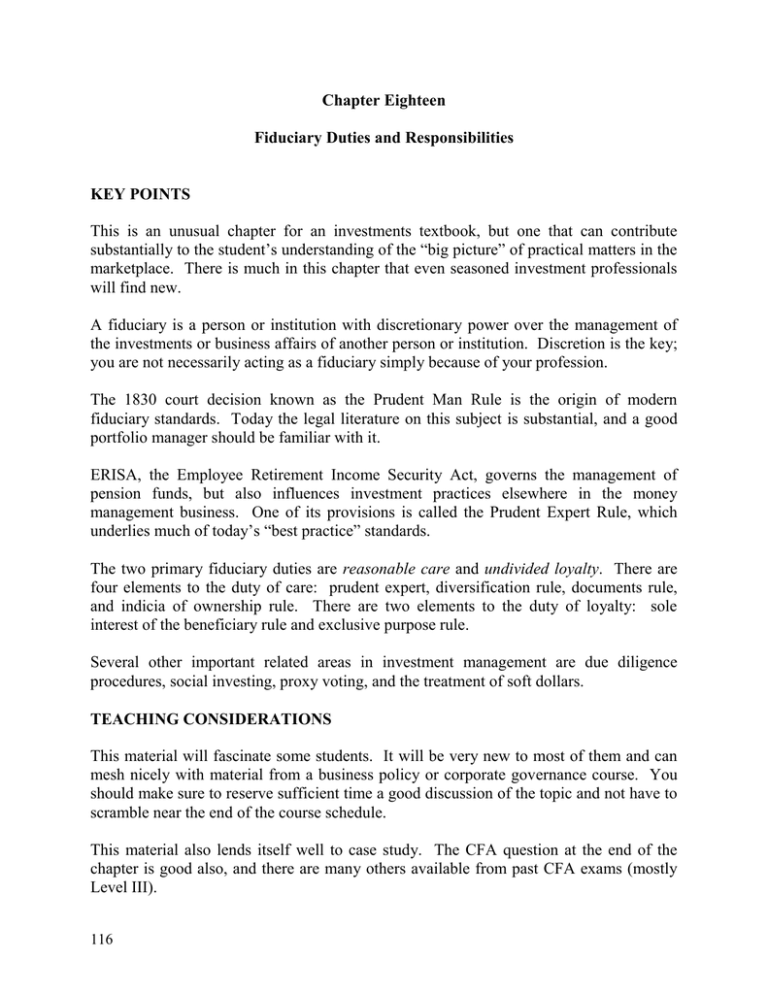
Chapter Eighteen
Fiduciary Duties and Responsibilities
KEY POINTS
This is an unusual chapter for an investments textbook, but one that can contribute
substantially to the student’s understanding of the “big picture” of practical matters in the
marketplace. There is much in this chapter that even seasoned investment professionals
will find new.
A fiduciary is a person or institution with discretionary power over the management of
the investments or business affairs of another person or institution. Discretion is the key;
you are not necessarily acting as a fiduciary simply because of your profession.
The 1830 court decision known as the Prudent Man Rule is the origin of modern
fiduciary standards. Today the legal literature on this subject is substantial, and a good
portfolio manager should be familiar with it.
ERISA, the Employee Retirement Income Security Act, governs the management of
pension funds, but also influences investment practices elsewhere in the money
management business. One of its provisions is called the Prudent Expert Rule, which
underlies much of today’s “best practice” standards.
The two primary fiduciary duties are reasonable care and undivided loyalty. There are
four elements to the duty of care: prudent expert, diversification rule, documents rule,
and indicia of ownership rule. There are two elements to the duty of loyalty: sole
interest of the beneficiary rule and exclusive purpose rule.
Several other important related areas in investment management are due diligence
procedures, social investing, proxy voting, and the treatment of soft dollars.
TEACHING CONSIDERATIONS
This material will fascinate some students. It will be very new to most of them and can
mesh nicely with material from a business policy or corporate governance course. You
should make sure to reserve sufficient time a good discussion of the topic and not have to
scramble near the end of the course schedule.
This material also lends itself well to case study. The CFA question at the end of the
chapter is good also, and there are many others available from past CFA exams (mostly
Level III).
116
Chapter Eighteen
Fiduciary Duties and Responsibilties
The Wall Street Journal frequently has an article dealing with the conduct of someone
who is alleged to have violated the duty of loyalty, in particular the “sole interest of the
beneficiary” rule. Account churning is a common example. You can generate good
related discussion by building various scenarios around soft dollar payments, directed
trades, front running, etc. You can also discuss the inherent conflict of interest a
commission stockbroker faces. If a customer trades, the broker gets a commission. How
does a supervisor ensure that employees are, in fact, acting solely for the benefit of the
customer?
I think it is likely that we will see more coverage of this topic in our textbooks in the next
few years. Part of the on-the-job education of an investment manager includes these
topics. We should also be covering them in the classroom.
ANSWERS TO QUESTIONS
1. A fiduciary is a person or institution that manages money and/or business affairs for
another person or institution. A fiduciary has discretion in management rather than
just being an order taker.
2. Harvard College v. Amory is the origin of modern fiduciary standards. This court
case was the first legal statement regarding proper trustee investment choices.
3. a. The prudent man rule states that a fiduciary should not speculate.
b. The rule does not define speculation.
4. a. The court dismissed the contention that the fact that an investment portfolio
appreciated in value is a defense against imprudent investment management.
b. The court also ruled that each portfolio component must be judged on the extent to
which it contributes to overall portfolio characteristics and the resulting likelihood
that the portfolio will serve the beneficiary well.
5. One the one hand, the Spitzer case requires that each portfolio component be
scrutinized. This raises the possibility that someone could focus on one particular
losing position and argue that it was an imprudent investment choice.
On the other hand, the Spitzer case recognizes that portfolio components are part of a
portfolio and that the prudence of a component ultimately depends on the portfolio in
which it is placed. This implies that portfolio focus is important.
117
Chapter Eighteen
Fiduciary Duties and Responsibilities
6. The prudent expert standard states that the standard of performance is not an ordinary
person (who may be unfamiliar with modern portfolio management); rather, it is a
person familiar with such matters and acting in a like capacity for a similar institution
with a similar investment policy. The standard essentially says that we need to see
what the experts are doing before making a judgement about the prudence of some
course of action.
7. See Table 18-1.
8. Reasonable care and undivided loyalty.
9. The documents rule requires the portfolio manager to handle investments in
accordance with the documents that govern the pension plan unless the documents
contain a provision that violates the duties of care or loyalty, ERISA, or state law
fiduciary rules.
The indicia of ownership rule requires that documents relating to asset ownership
must be under the jurisdiction of the U.S. court system. This is to ensure that legal
disputes can be settled in U.S. courts.
10. The manager must obey ERISA and other laws ahead of the plan provisions.
11. Under ERISA a party in interest is a person or organization who has some relationship
to a pension plan.
12. A manager may pay more than the minimum in commissions if the manager gets
value in return. This value might come from better order execution or from research
material.
13. Due diligence is an imprecise standard of “prudent behavior” in a particular
circumstance.
14. The manager should take the fund’s wishes into account when making investment
decisions and honor them when doing so would not reduce the likelihood that the fund
will achieve its objectives.
15. Just voting proxies is not enough; you must vote them in the beneficiary’s best
interest.
16. CERES stands for the Coalition for Environmentally Responsible Economies. The
CERES principles endorse various measures to protect the environment, including
waste disposal standards, energy conservation, protection of the biosphere, etc.
118
Chapter Eighteen
Fiduciary Duties and Responsibilties
17. Suppose there are 1 million shares of stock outstanding and that there are four open
board seats. Management re-nominates each of the directors whose term is expiring
for another term. A labor group proposes a fifth candidate; union members
collectively own 20% of the outstanding shares. With non-cumulative voting, the
labor group candidate would need a positive vote from 25% of the shares to be
elected. Getting 5% of the non-union shares to vote against management’s
recommendation is nowhere near a sure thing.
With cumulative voting things would be easier. Owning 200,000 shares and with 4
directors to be elected, the union will cast 800,000 votes. The other shares
outstanding will cast 800,000 x 4 = 3,200,000 votes. If the outstanding shares spread
their votes equally each of the four nominees would get 800,000 votes; presumably
the union candidate would also get 800,000. This means if any other shareholder
voted against management the labor group would be certain of electing their person.
18. a.
b.
c.
d.
vote in person at the annual meeting
return the paper proxy
vote over the Internet
vote via a touchtone telephone
19. A soft dollar arrangement is one in which products or services other than execution of
securities transactions are obtained by an advisor from or through a broker-dealer in
exchange for the direction of trades to the broker-dealer.
20. a. Research reports
b. News
c. Pricing services
21. Student response.
22. Student response.
23. CFA Guideline Answer (reprinted with permission from the CFA Study Guide, CFA
Institute, Charlottesville, VA. All Rights Reserved.
A. (i) “A decision in invest in a company entails a responsibility to vote proxies.”
Validity. This statement is true as far as it goes, but it does not go far enough.
Plan fiduciaries cannot be passive shareholders. Proxy voting rights are
considered assets of a pension plan, and as such, proxy voting involves the
exercise of fiduciary responsibility under ERISA. Votes must be cast in a way
that the fiduciary believes will maximize the economic value of plan holdings.
119
Chapter Eighteen
Fiduciary Duties and Responsibilities
The fiduciary has a duty to make investment decisions solely in the interest of
participants and beneficiaries and exclusively to provide benefits to the
participants and beneficiaries.
Primary Fiduciary Duties Concerning Proxy Voting
1. Examine underlying issues. Voting requires a thorough examination of the
underlying issues, and those who do the voting must be qualified to make
informed decisions. The plan document should state who has the authority
and responsibility to vote proxies.
2. Keep adequate records. Adequate record keeping tasks must be performed,
including keeping a record of stock held, reconciling proxies received with
stock held on the record date, tracing missing proxies, and keeping a record of
how and why proxies were voted.
3. Designate an individual or group to recommend and implement proxy
voting policy. The investment firm should designate a policy-making body or
an individual from within its ranks to recommend proxy policy and monitor
implementation.
4. Identify proxy issues by accounts. Major proxy issues should be identified
by particular accounts and preferences of beneficiaries, participants, or
individuals for whom the funds are held should be noted.
5. Establish a review process for controversial or unusual proposals. The
investment firm should set specific guidelines and put in place a regular
review process.
6. Train staff. The firm’s staff should be educated and trained on proxy voting
policies and guidelines.
Secondary Fiduciary Duties Concerning Proxy Voting
1. Initiate and/or cosiqn shareholder proposals. The fiduciary should discuss
the issues with those who do the voting and decide whether additional action is
necessary; that is, to initiate and/or cosign shareholder proposals.
2. Evaluate corporate performance. The fiduciary should consider applying to
proxy decisions internal financial ratios or other criteria for evaluating
corporate performance. Evaluate proxy proposals against the history and
productivity of current management and the conceptual reasons for or against
the proposal.
120
Chapter Eighteen
Fiduciary Duties and Responsibilties
3. Provide a process for antimanagement votes. The fiduciary should provide
a process for deciding whether a vote against management should be preceded
(or followed) by a letter, telephone call, in-person discussion with corporate
personnel, and/or action to be taken with other concerned firms and
organizations.
4. Decide exclusions from voting. The fiduciary should decide under what
conditions those who hold a concentration of stock in their names of have other
vested interests in the corporations in which stock is held should not participate
in voting.
5. Report to clients. The fiduciary should decide how and when to report
positions taken during the proxy season to clients and sponsors.
6. Monitor delegation of responsibility. The fiduciary should develop a system
to monitor any delegation of responsibility to others.
7. Monitor custodian. The fiduciary should provide for monitoring performance
of the custodian or its agent to ensure timely receipt of proxies.
8. Avoid or minimize conflicts of interest. The fiduciary should avoid or
minimize conflicts of interest and, when possible, consider instituting “Chinese
Wall” techniques to proxy voting.
(ii) “You have breached your fiduciary duty as a manager if you have caused an
account under your control to ‘pay up’ (i.e., pay a brokerage commission larger
than that charged for a trade done on a ‘best execution’ basis) on a transaction for
the account.”
Validity. This statement is false.
An investment manager can “pay up” in brokerage commissions if the
commissions are reasonable relative to the value of the brokerage and research
services received. Further, the investment manager can make this determination,
assuming it is done in good faith. An excessive payment, however, could violate
the fiduciary rule of prudence and give rise to the charge that the services
represented by the excess fees were wrongfully appropriated client assets and
diverted to the fiduciary’s own benefit. Brokerage commissions are considered a
plan asset. Fiduciaries are forbidden from using assets of their clients or a plan’s
participants and beneficiaries for their own benefit based on ERISA’s “exclusive
benefit” requirement.
121
Chapter Eighteen
Fiduciary Duties and Responsibilities
1. Show that services add value to the decision-making process. The full
range and quality of a broker’s services must be considered in addition to
commission rate. For example, important factors are execution capability,
quality of research, and responsiveness to the investment manager. The key is
that the investment manager must show that the services received had
decision-making value commensurate with their cost.
The critical element distinguishing legal from illegal behavior is the nature of
research, defined in a 1986 Interpretive Release of the SEC as “information
which provides lawful and appropriate assistance to a money manager in the
performance of his investment decision-making responsibilities.”
One authority states that the law is ambiguous about the status of the payment
of soft dollars: “Given adequate disclosure and a good faith effort to allocate
payments to research functions, paying for brokerage and research services
with soft dollars is a legitimate prerogative of the money manager.”
2. Disclose brokerage commission allocation policies and commissions paid.
Full disclosure of brokerage commission allocation policies and actual
commissions paid, plus client consent, would serve to lessen conflict-ofinterest situations.
3. Maintain records. The manager must keep accurate and detailed records of
transactions involving soft dollars.
B. “Social investing is inconsistent with the requirements of ERISA.”
Validity. Although this statement is neither true nor false on its face value, it is
closer to the truth than not. The appropriateness or legitimacy of social
responsibility criteria for a pension fund is questionable in a fiduciary context.
Although ERISA has no definitive statement on social investment, nothing in
ERISA suggests using pension assets for anything other than financial goals.
Arguments Favoring the Statement
1. ERISA’s exclusive benefit statement. Opponents of social investment feel it
leads to violating ERISA’s fiduciary responsibility and prohibited transaction
rules, and compromises the safety, return, and marketability of a plan’s
portfolio. According, social investing could create problems under ERISA’s
prudence and diversification requirements.
122
Chapter Eighteen
Fiduciary Duties and Responsibilties
2. ERISA’s diversification requirement. Factors to be considered in meeting
prudence and diversification requirements do not include social goals. The
fiduciary may not deviate from ERISA’s diversification requirement, which
requires diversification of pension assets across asset classes and across
securities within asset classes to minimize the risk of loss.
3. ERISA’s requirement that pension assets must be used only for financial
goals. Any plan excluding investment possibilities for social purposes without
considering their economic and financial merit may be showing insufficient
care for and disloyalty to individuals covered by the plan. To concentrate a
plan’s assets to serve an “excluded purpose” conveys some sense of
imprudence.
Although not a significant factor, empirical studies show the market does not
price social responsibility characteristics. That is, social responsibility factors
do not affect expected stock returns. If social investing does not have an
economic effect on the Fund, it seems to go beyond the scope of the fiduciary
relationship defined by ERISA and, therefore, appears to be an improper
exercise of fiduciary responsibilities.
Arguments Against the Statement
1. Favorable effect on earnings. A possible rationale for fiduciary-acceptable
social investing is that the public view of a company’s social commitment (or
a company’s labor relations, for example) may favorably affect a firm’s
profitability. This effect may favor investing in a particular “socially
responsible” company compared with alternative investments available to the
plan.
2. Safety in numbers. Another rationale, upheld by some courts, is that the
chief test of prudence is whether other trustees commonly hold an investment.
For example, trust funds and institutional investors may hold the investment.
This is the safety-in-numbers argument.
3. No adverse court rulings. Although some pension plans may engage in
social investing, they may be challenged under ERISA because social
investing may not be solely in the interest of plan participants. To date, no
court has found that an investment manager breached his fiduciary duty by
investing based on social responsibility.
123
Chapter Eighteen
Fiduciary Duties and Responsibilities
4. Comparable returns. Empirical studies are somewhat ambiguous in terms of
addressing this specific question and are inconclusive about whether socially
responsible investments provide real benefit to the participants or involve any
sacrifice of portfolio returns.
The Standards of Practice Handbook states that social investing might be
permissible assuming “the investment manager ensures that such investments
do not impair the integrity of the funds in question or the financial security of
the participants.”
C. “Adverse investment outcomes may trigger inquiry into a fiduciary’s conduct and
may influence a court’s judgment as to prudence and the extent of any liability.
Nevertheless, ERISA’s ‘Prudent Expert Rule’ is more properly termed a rule of
conduct a rule of investment performance.”
Validity. This statement is true.
1. Courts have based findings of imprudence less on the type of investment at
issue than on the fiduciary’s failure to undertake a thorough and diligent
analysis of an investment’s merits that may have revealed the unsuitability of
that investment or the existence of alternative investments offering a more
favorable risk/return trade-off. The emphasis is on competence and process,
not on the resulting investment performance. For example, did the investment
manager consistently follow a set of well-reasoned investment policies?
2. A loss on an investment would not be considered imprudent by itself, nor
would a gain on an investment guarantee a finding of prudence.
Components of the Rule
ERISA’s prudence standard, known as the Prudent Expert Rule, requires a pension
fiduciary to
Exercise the care, skill and diligence under circumstances then prevailing,
That a man in similar capacity, and
Familiar with such matters would use
In the conduct of an enterprise of a like character with similar aims.
D. “An investment manager’s responsibilities with respect to ERISA’s requirements
take precedence over the plan documents and objectives in case of a conflict
between these and the ERISA requirements.”
Validity. This statement is true.
124
Chapter Eighteen
Fiduciary Duties and Responsibilties
Explanation of the conclusion. A plan must be administered according to the
documents governing the plan. Yet, plan documents are to be followed only to the
extent that they are consistent with ERISA requirements. An ERISA fiduciary
must not comply with investment provisions or a plan document that contravenes
the statutory standards under ERISA. ERISA places on the fiduciary the
additional burden of investigating whether the plan instrument and investment
objects are permissible under ERISA.
The Standards of Practice Handbook states, “When developing investment
objectives for an account, one should include an understanding of fiduciary duties
and identify the individual or body to whom such responsibility is owed.”
The safest way to avoid liability is to develop reasonable and appropriate
investment policies and objectives according to ERISA followed by the
development of a rational investment approach to achieve these objectives.
If the beneficiaries of a closely held plan request that their investment manager
invest all the plan assets in a single security, the individual manager could not do
so under ERISA. This action violates the diversification rule and the level of
diversification implied by the requirement for prudence. This requirement is
contrary to trust law of many jurisdictions, primarily state and provincial, which
allows the fiduciary to follow the express directives contained in plan instruments
without fear of liability.
125


